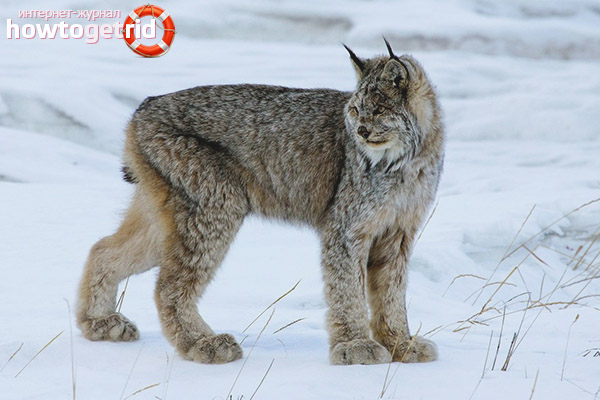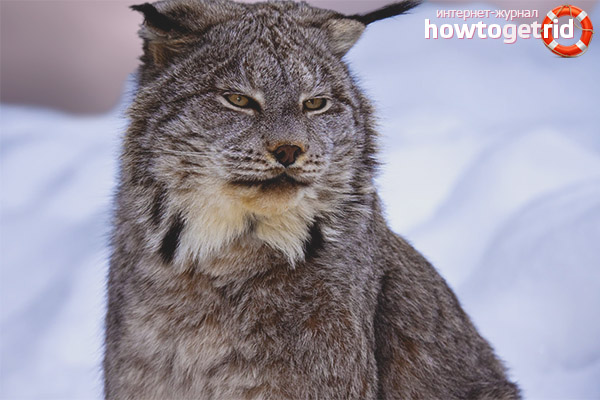The content of the article
Canadian trot means a beast that is distinguished by its habitat. These individuals like the forest area. They lead a fairly closed lifestyle, but are very mysterious and interesting to study. Like other varieties of this family, lynxes differ in the habits of wild cats. They are famous for their grace. As for distribution, most of the population is dispersed throughout Canada, other inhabitants are in the vastness of the northern part of the United States.
Description
- These individuals are classified as medium-sized, similar to red lynxes. In terms of coat color, they can be brown-yellow, light brown or gray-yellow. The upper body is darkened, the bottom is highlighted and stands out in tone from the other sections of the body. Most members of the family have dark spots.
- The tail is shortened, black pigment is present at the end. The coat is long and dense, so the animals are protected from the weather. When the cold is only approaching, the sideburns begin to grow in lynxes. They cover the cervical spine and also partially protect.
- The ears are in the format of a triangle with black tassels at the ends that extend up to 4 cm. The limbs are fluffy and large, the animal moves well in the snow, without feeling discomfort. The limbs at the back are longer, approximately the same as in the lynxes pigmented by the redhead. Along the length of the hull, animals grow to 1 m on average. In addition, about 15 cm is assigned to the tail. The height at the withers is 0.5 m. The weight category is in the range of 4.5-17 kg.
- Differences in gender are only in the fact that male representatives of the family are slightly larger than females. If we compare the variety under discussion with the common trot, the latter is twice as large.
- In animals, the jaws are equipped with four powerful fangs, and the entire dentition consists of 28 teeth. Lynxes sense the victim's bite area with their fangs. Due to this, they have the opportunity to damage a lot of nerve endings. Retractable claws, sharp and strong.
- Comparing these individuals with red representatives of the family, it should be said that the former are less reddish in pigmentation. They also have longer brushes at the ends of the ears, spotting appears more clearly, the tail is more shortened, and the limbs are more powerful and larger. Red animals are small in size.
Food
- Most of the basic menu is reserved for meat; an individual should eat it in an amount of 3 kg per day. It is required for a full existence. Most often, lynx hunt hares, in a year an individual kills about 200 eared. Thanks to this, it is possible to adjust the population, because hares quickly breed.
- In addition, deer, squirrel, beaver, mouse, bird, fish, and snow sheep may be included in the diet. If the animal did not eat the food immediately, it hides its food and returns to stocks later.
- Typically, a recess in the soil serves as a cache. Small predators look for stocks of lynxes, pull them apart and divide among themselves. When the animal is full, it does not prepare for the hunt, but calmly cools in its den.
Behavior
- Earlier it was mentioned that individuals are characterized by a hidden way of being. They communicate with each other extremely rarely, but cannot make friends because of the nomadic nature of their stay. Usually an individual occupies the territory on which it hunts (more than 70 sq. M.). The area is marked with urine and scratches.
- Thanks to its powerful and fluffy paws, the lynx confidently and quickly moves along the snow cover. It does not matter what it is, loose or icy.Moreover, the individual sweeps tracks, also feels great in the water, can skillfully climb trees and rocks.
- When a mammal is in search of food, it can cover more than a dozen kilometers. Especially if there is no feed in the distribution area. When the weather is bad, the lynx will ride it and set off again. Can cross sections even in the coldest water.
- A distinctive characteristic of representatives of the family under discussion is considered to be that they conduct hunting not only after sunset. The specimens are adapted to the food of the day, which cannot be said about ordinary lynxes. The animal looks down prey, then throws jumps of 3 meters in length.
Area
- The considered individuals mainly live throughout Canada. Wild animals are most commonly found in areas of Washington, Idaho and Western Montana. Presented cats live in small populations in Utah and New England.
- Very rarely, such animals can be found in Colorado, Oregon and Wyoming. Forests with dense vegetation are mainly considered habitual habitats of the presented individuals. However, cats feel good in open forests, tundra, rocky terrain.
Breeding
- It is noteworthy that individuals converge in pairs exclusively during the mating season. This time starts from the end of winter and lasts until mid-spring. The male independently chooses several females on its territory. After he fertilizes his companions, he retires according to his business.
- Subsequently, only the mother takes care of the offspring. After the mating season, the pregnancy lasts approximately 2 months. Before giving birth, the female finds a secluded, safe lair, and then equips it. Most often, the dwelling is chosen in crevices of rocks, dense vegetation and hollows of trees.
- Then, for several days, the mother expects the birth of offspring. Often up to 5 kittens are born. Each weighs no more than 350 grams. At such a time, the kids are blind, deaf and completely helpless. Without maternal protection and guardianship, they will not survive. After half a month, they see clearly.
- It is noteworthy that such small lumps with bright blue eyes will soon grow into ruthless predators. The first few months, young growth continues to be fed breast milk. From the age of 4 months, solid food gradually begins to enter their diet. Mother tries to feed babies with a rabbit.
- Kittens learn all the intricacies of hunting gradually. For prey, the mother takes her cubs from six months already. At this time, they observe the entire hunting process. Literally, when the kids are 10 months old, they are forced to leave their mother. She, in turn, begins to prepare for the mating season.
- Lynxes already live a full independent life. Otherwise, they will soon reach puberty and begin to look for a mate. They choose their territory and begin to inhabit it. On average, such cats in vivo live about 10 years.
It is not completely clear how the individuals in question relate to humans. For example, in the wild, such cats try to avoid people in every possible way. But at the same time, lynxes do not feel any fear. On the other hand, the animals in question often settle nearby settlements. They can sometimes go there.
Video: Canadian Lynx (Lynx canadensis Kerr)












Submit